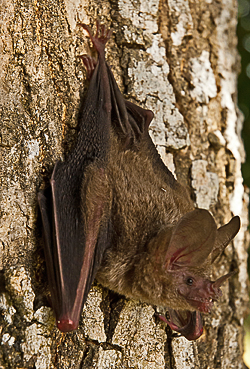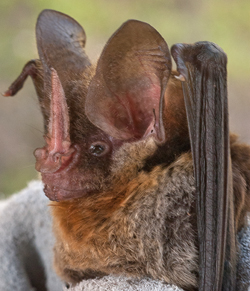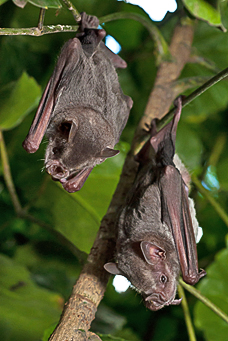Bat Ecology
Ryan Shipley
 Bats have the second greatest number of species in mammals (around 1200), with only the rodents containing more. However, in no other family of mammals is there greater ecological diversity than in the leaf-nosed bats (Phyllostomidae) which contains roughly 160 species with representatives that range in body size from several grams (Vampyressa pusilla) to the largest bat in the New Word (Vampyrum spectrum). They occupy a tremendous range of ecological niches, with species occupying different dietary niches such as nectar, fruits, insects, small vertebrates and even blood. In many place in the Central American tropics, more than 30 species of leaf-nosed bats can be found in the same several hectares of forest. Despite their ability to exploit novel and unique ecological niches, many species are in decline due to habitat loss and encroachment.
Bats have the second greatest number of species in mammals (around 1200), with only the rodents containing more. However, in no other family of mammals is there greater ecological diversity than in the leaf-nosed bats (Phyllostomidae) which contains roughly 160 species with representatives that range in body size from several grams (Vampyressa pusilla) to the largest bat in the New Word (Vampyrum spectrum). They occupy a tremendous range of ecological niches, with species occupying different dietary niches such as nectar, fruits, insects, small vertebrates and even blood. In many place in the Central American tropics, more than 30 species of leaf-nosed bats can be found in the same several hectares of forest. Despite their ability to exploit novel and unique ecological niches, many species are in decline due to habitat loss and encroachment.
Much of my current research involves questions about animals use habitat throughout the seasons, whether short distance (<100 km) movements or larger (>100 km) continental scale migrations. For a population of organisms to be able to survive over multiple generations, several keys requirements have to be satisfied. Organisms compete both with similar individuals of the same species (intraspecific) and other species (interspecific) for the necessary resources required for successful reproduction, food for growth and maintenance, and avoidance of predators. The unique advantages of flight in organisms such as bats, birds, or insects have provided innovative ways for species to use these resources spatially, but also present additional challenges for their study.
 Many of the organisms I am interested in are relatively small (< 15 grams body mass) which greatly limits the ability to track individuals using Global Positioning System (GPS) transponders or radio-telemetry. Although they provide high resolution location data year-round, currently the GPS devices are simply too large to use with animals of this body size and battery life restricts the use of VHF radio to track animals for any considerable amount of time. Presented with these limitations, my research has focused on using methods such as stable isotopes and mark-recapture in different habitats types to determine where individuals select roost sites and obtain resources throughout the year. Considering some bat species have been documented to move over 40 km in a single evening, capturing an organism at a single point says little about where it spends its time obtaining resources for survival or reproduction, simply that it was there on a given time. For this reason we have surveyed individuals across multiple sites and temporal scales to get a more integrative understanding of these seasonal movements and use of resources.
Many of the organisms I am interested in are relatively small (< 15 grams body mass) which greatly limits the ability to track individuals using Global Positioning System (GPS) transponders or radio-telemetry. Although they provide high resolution location data year-round, currently the GPS devices are simply too large to use with animals of this body size and battery life restricts the use of VHF radio to track animals for any considerable amount of time. Presented with these limitations, my research has focused on using methods such as stable isotopes and mark-recapture in different habitats types to determine where individuals select roost sites and obtain resources throughout the year. Considering some bat species have been documented to move over 40 km in a single evening, capturing an organism at a single point says little about where it spends its time obtaining resources for survival or reproduction, simply that it was there on a given time. For this reason we have surveyed individuals across multiple sites and temporal scales to get a more integrative understanding of these seasonal movements and use of resources.
 Preservation of habitat for species that migrate throughout the year creates many additional challenges not observed with terrestrial organisms. Considering many migratory songbirds and some bats make trans-continental migrations annually, conservation efforts of critical habitat often have to span international borders. If a population uses multiple sites throughout the year, whether for stopover, breeding or overwintering, each of these places represents an important aspect of its migratory ecology. Loss of critical habitat at any one of these sites can have detrimental effects to a population of animals and highlights the need for understanding where migratory animals move throughout the year and the importance of certain habitats or resources.
Preservation of habitat for species that migrate throughout the year creates many additional challenges not observed with terrestrial organisms. Considering many migratory songbirds and some bats make trans-continental migrations annually, conservation efforts of critical habitat often have to span international borders. If a population uses multiple sites throughout the year, whether for stopover, breeding or overwintering, each of these places represents an important aspect of its migratory ecology. Loss of critical habitat at any one of these sites can have detrimental effects to a population of animals and highlights the need for understanding where migratory animals move throughout the year and the importance of certain habitats or resources.


